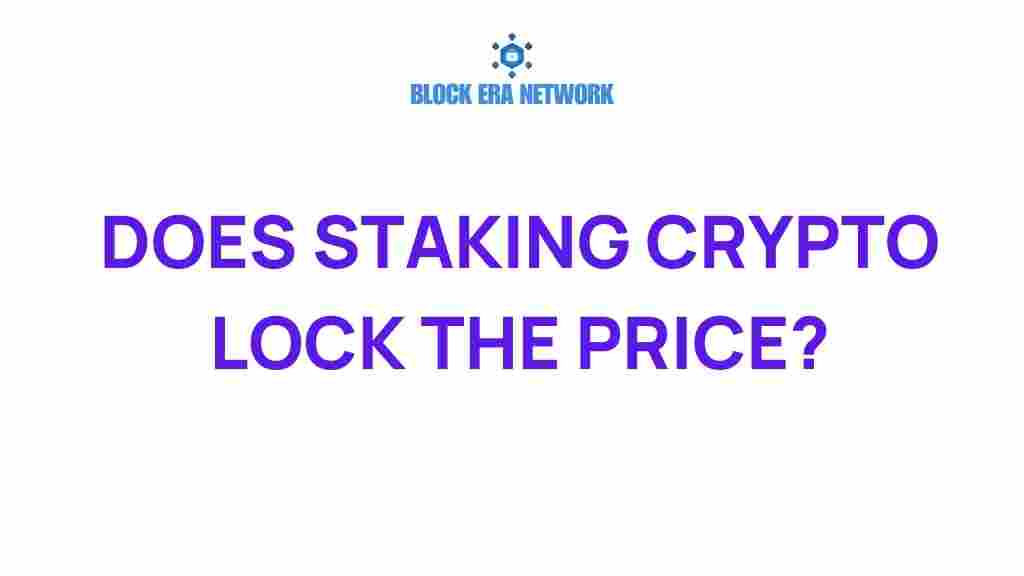Does Staking Crypto Lock in Prices?
In the rapidly evolving world of cryptocurrency, many investors are on the lookout for innovative ways to earn passive income while safeguarding their digital assets. One popular method that has gained traction is staking crypto. However, a common misconception is that staking can lock in prices, providing a safety net against market volatility. In this article, we will unravel the myths and realities of staking crypto, exploring its implications, benefits, and risks within the broader context of investment strategies in the realm of DeFi (Decentralized Finance) and blockchain technology.
Understanding Staking in Cryptocurrency
Staking involves participating in the proof-of-stake (PoS) consensus mechanism by holding and “staking” your cryptocurrency in a wallet to support the operations of a blockchain network. In return, participants earn rewards, typically in the form of additional coins or tokens. This practice not only helps secure the network but also contributes to the overall health of the blockchain ecosystem.
How Staking Works
To understand how staking crypto works, it’s essential to break down the process:
- Selection of a Cryptocurrency: Choose a cryptocurrency that supports staking. Popular options include Ethereum 2.0, Cardano, and Polkadot.
- Set Up a Wallet: Create a wallet that allows for staking. Many exchanges also offer staking services.
- Deposit Coins: Transfer your chosen cryptocurrency into your wallet.
- Start Staking: Initiate the staking process through your wallet or exchange.
- Earn Rewards: As you stake, you will start receiving rewards, typically calculated based on the amount of cryptocurrency you have staked.
Can Staking Crypto Lock in Prices?
The notion of “locking in prices” through staking is misleading. While staking can provide a form of stability to your investment by generating passive income, it does not prevent the value of your staked assets from fluctuating with market conditions. Here are some critical points to consider:
Market Volatility and Price Fluctuations
Cryptocurrency markets are notoriously volatile. The price of any digital asset can rise or fall dramatically within short periods due to various factors such as:
- Market sentiment and investor behavior
- Changes in technology or regulations
- Macroeconomic trends and events
When you stake crypto, you earn rewards, but the underlying asset’s price remains subject to these fluctuations. Therefore, while staking can provide returns, it does not lock in the price of the cryptocurrency.
Staking as a Risk Management Strategy
While staking crypto does not lock in prices, it can serve as a risk management strategy for investors. Here’s how:
- Passive Income Generation: By staking, you can earn rewards that can offset potential losses from price declines.
- Long-Term Holding: Staking encourages investors to hold onto their assets longer, which may help them weather short-term volatility.
- Community Incentives: Many blockchain networks reward long-term stakers, aligning incentives with the network’s health and growth.
The Benefits of Staking Crypto
Staking offers several advantages for investors looking to maximize their cryptocurrency holdings:
- Earn Passive Income: Staking can provide a consistent stream of income without the need to actively trade.
- Support Blockchain Networks: By staking, you contribute to the security and efficiency of blockchain networks.
- Potential for Price Appreciation: While staking does not lock in prices, holding staked assets may lead to long-term capital gains.
Challenges and Risks of Staking
Despite its benefits, staking crypto comes with its own set of challenges and risks:
- Market Risk: The value of staked assets can decrease, leading to potential losses.
- Liquidity Risk: Some staking options require you to lock in your assets for a fixed period, limiting your access to funds.
- Technical Risks: Issues such as network outages or bugs can affect your staking rewards.
How to Get Started with Staking Crypto
If you’re interested in staking crypto as part of your investment strategy, follow this step-by-step guide:
Step 1: Research and Choose a Cryptocurrency
Look for cryptocurrencies that offer staking. Popular options include:
- Ethereum 2.0
- Cardano (ADA)
- Tezos (XTZ)
- Polkadot (DOT)
Step 2: Select a Staking Platform
Choose a platform to stake your coins. You can opt for:
- Cryptocurrency Exchanges: Many exchanges offer user-friendly interfaces for staking (e.g., Binance, Coinbase).
- Dedicated Staking Services: Platforms like Kraken and BlockFi provide staking options.
- Wallets: Some wallets have built-in staking features (e.g., Exodus, Atomic Wallet).
Step 3: Set Up Your Wallet
Once you’ve chosen a platform, create and set up your wallet. Ensure you follow security best practices, such as enabling two-factor authentication.
Step 4: Deposit Your Cryptocurrency
Transfer the desired amount of cryptocurrency into your staking wallet. Make sure to check the minimum staking requirements for your chosen cryptocurrency.
Step 5: Begin Staking
Follow the platform’s instructions to start staking your assets. Monitor your staking rewards and keep track of any changes in the market.
Troubleshooting Staking Issues
While staking can be straightforward, you may encounter issues. Here are some troubleshooting tips:
- Verify Staking Status: Check your wallet or platform to ensure your assets are actively staking.
- Monitor Rewards: If you notice discrepancies in rewards, consult the platform’s support resources.
- Stay Informed: Keep updated with news related to the cryptocurrency you’re staking, as changes can affect your rewards.
Conclusion: The Realities of Staking Crypto
In conclusion, while staking crypto offers a unique avenue for earning passive income and supporting blockchain networks, it does not lock in prices. Investors should approach staking with a clear understanding of the associated risks and market dynamics. By integrating staking into a diversified investment strategy, you can leverage its benefits while remaining aware of the ever-present market volatility.
As you explore staking and other investment strategies, remember that thorough research and continuous learning are paramount. For further information on cryptocurrency investments and strategies, check out this in-depth guide and stay updated with the latest trends in the digital asset market. Happy staking!
This article is in the category Decentralized Finance (DeFi) and created by Block Era Network Team
